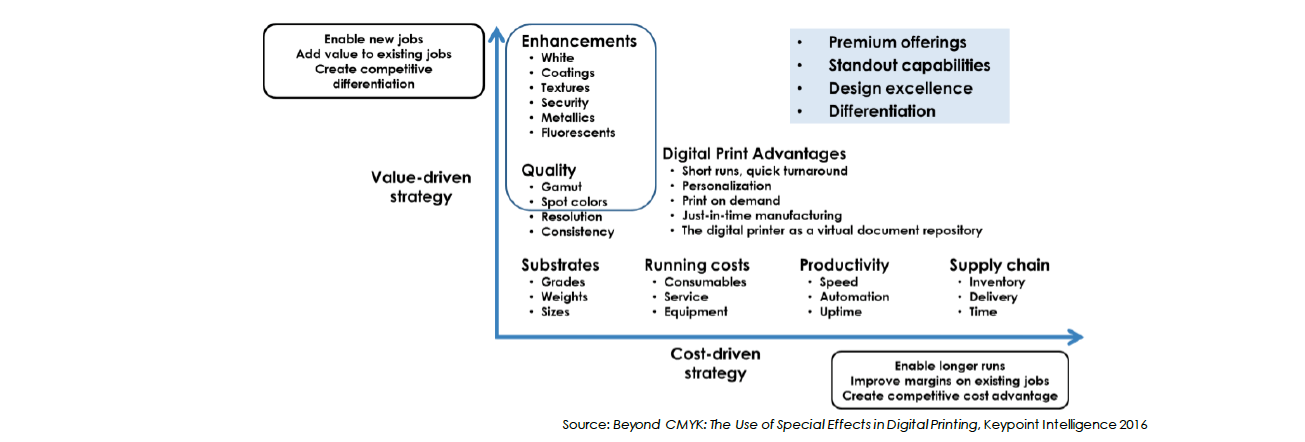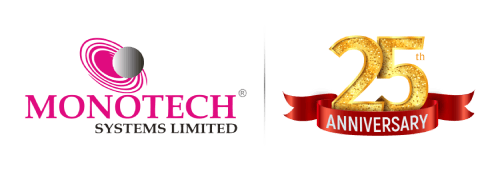Direct Mail with Print Enhancements

Figure 1: Print Enhancement Examples
Direct marketing campaigns can vary widely in quality, encompassing everything from unimaginative and generic junk mail to highly targeted and personalized initiatives. The former has been rightfully tagged with unflattering nicknames like “spray & pray” and “carpet bombing.” This document explores how implementing printing techniques beyond conventional process color1 can be used as part of a value-driven communications strategy.
What Do We Mean by Print Enhancements?
Commercial printers and direct mailers have been using print enhancements for decades. Familiar examples include a specially mixed ink color or a Pantone Matching System (PMS) ink. Digital print also has a long history of being used for print enhancements. For black & white digital print, the most common example is the use of MICR (magnetic ink character recognition) techniques for check printing. This enables printed checks to be processed at high speeds via automated code readers. Some of the earliest production color digital printing systems allowed the use of one or more colors in addition to CMYK. These features have really expanded over the past 5 to 10 years, so print enhancement features are now relatively common on production color digital printing systems. In addition, a relatively new class of digital devices enables print enhancements like spot gloss, dimensional effects, and foil to be added to existing offset or digital print output in an off-line process.
A 2016 Keypoint Intelligence study entitled Beyond CMYK: The Use of Special Effects in Digital Printing explored the use and value of print enhancements. In that study, researchers showed a set of samples to print buyers with the intent of gauging their reaction to the value of individual print enhancements. The areas covered included:
- Spot Colors: Red, green, or blue as spot colors or for use in expanding the color gamut of CMYK process color
- Metallics: Such as gold & silver
- Fluorescent Colors: Such as neon pink or yellow
- White Ink: Opaque white allows more effective process color printing on colored papers and also opens up creative design opportunities
- Foil: Digital techniques can now simulate cold and hot foil stamping methods
- Infrared (IR)/ Ultraviolet (UV): Special security effects for documents like tickets and identity cards
- Textured: Dimensional effects that simulate embossing by applying layers of variable thickness
- Spot or Flood Coating: Spot clear coating for localized gloss or matte effects; flood coating for protection and matte or gloss visual effects
Keeping these types of print enhancements in mind, the real question for direct mailers is, how can these capabilities be leveraged to make campaigns more effective?
What Do Print Buyers Think about Print Enhancements?
In its Beyond CMYK study, Keypoint Intelligence asked print buyers in the United States and Western Europe about the importance of key factors related to print enhancements when buying or designing print. Top among those factors was print quality, which garnered a rating of 4.6 on a 5-point scale. Drawing attention to the mail piece and enhancing the brand followed close behind. Differentiating the piece and creating an emotional connection with customers ranked at 4.2 and 3.9 out of 5, respectively. Factors like protecting the piece from damage and security issues (i.e., preventing counterfeiting) came in relatively low on the scale. It should be noted that a security feature like an IR or UV ink that prevents counterfeiting would be highly valuable for certain marketers, but of less interest to many others.
Figure 2: Importance of Factors When Buying and/or Designing Print

A 2019 SGIA/NAPCO Research study entitled Adding Value to Digital Printing also explored the benefits of print enhancements and came to very similar conclusions as the Keypoint Intelligence study. The SGIA/NAPCO researchers concluded that the top four benefits that marketers and brand owners valued were:
- Giving the brand a premium look
- Capturing the attention of recipients
- Helping campaigns stand out from the competition
- Enhancing the brand or corporate image
Spot coatings can be a valuable way of bringing attention to any element in a printed piece, but they can be particularly important as a means of connecting the physical to the electronic world via codes or web addresses like personalized URLs. According to the Keypoint Intelligence study, the applications best suited for spot for flood coating included brochures, business cards, and direct mail postcards & letters.
Figure 3: Top Business Applications for Spot or Flood Coating

Other print enhancements like metallic inks, textures, foils, and fluorescent effects can also serve the same purpose as a glossy spot coating.
The Role that the USPS Plays in Print Enhancement
The United States Postal Service (USPS) is bound by a concept called the Universal Service Obligation, which simply means that it must provide universal postal service to the public at affordable prices. As a service, the USPS is constantly seeking ways to promote the usefulness of direct mail. One 2019 USPS initiative encouraged the use of print enhancement. The goal of the so-called Tactile, Sensory, & Interactive Mail piece Engagement Promotion was to leverage the physical aspects of mail as well as advancements in print technology to help marketers enhance how their customers interacted with mail to drive response rates. During this promotion, eligible mailers who incorporated a multi-sensory experience (e.g., special visual effects, sounds, scents, texture/tactile treatments, or even taste) in their mail pieces could be eligible to receive a postage discount. The USPS reports that the program was a success and it is considering repeating it in the future.
Other USPS programs intended to promote creative uses of the mail included a Personalized Color Trans Promo promotion, an Emerging & Advanced Technology promotion (for tools like near field communication tags), and a Mobile Shoppint promotion. These promotions were designed to encourage best practices in personalization, coordinated messaging across different channels, and the integration of technology to enhance the customer experience. Direct mailers and their marketing counterparts must keep aware of current USPS mailing programs to ensure that they are taking advantage of all possible discounts associated with technology use.
For direct mail to maintain and grow its effectiveness, mailers must integrate links to digital and mobile communications. One good way to highlight bar codes, web links, and promotional codes in print is through the use of print enhancements as part of designs that connect the reader to the virtual world.
Another important aspect of the USPS for direct mailers is Informed Delivery, a service that enables consumers to preview scanned images of their household mail before it arrives in their mailbox. In addition, mailers are able to integrate digital elements to their campaigns to enhance and extend what the USPS describes as the “mail moment.” The USPS reports that the feature has an 89% customer satisfaction rate and that 93% of users would recommend it. From an Omni-channel perspective, Informed Delivery is important because it generates multiple impressions from a single mail piece (digital and physical). From a print enhancement perspective (as well as for any marketing technique used), it provides a tool to assess the impact of a campaign. Knowing when a piece drops in a mailbox is a small part of Informed Delivery, but it is an extremely valuable one.
Print Enhancement as Part of a Value-Driven Strategy
How do you measure the nature of a print service provider? One way is to see where they fit on a scale of value and cost. Print providers generally use a combination of two strategies:
- Cost-driven: This strategy focuses on enabling longer runs, improving margins on existing jobs, and creating a competitive cost advantage. It focuses on things like running costs and overall productivity.
- Value-driven: This strategy focuses on enabling new jobs, adding value to existing jobs, and creating competitive differentiation.
Figure 4: Print Enhancements as Part of a Value-Driven Strategy

In the case of substrates, these can be bought at the best price possible to support a cost-driven strategy, but premium substrates can also be used to support a value-driven strategy. Key to a value-driven strategy are aspects like quality and print enhancements.
With digital print, there are also many associated advantages, including the ability to produce affordable short runs and turn them around quickly. Personalization, either as true one-to-one, or in segmented or targeted use, is another key advantage. Capabilities like print on demand, just-in-time manufacturing, and the ability to use the digital printer as a virtual document repository also separate digital print from conventional methods like offset. These capabilities bring with them supply chain advantages that can contribute to extremely effective operations in a cost-driven strategy, not to mention the value they bring to customers.
Of all of these, quality factors (such as extended color gamut and the use of spot colors) plus a range of enhancements (such as white, coatings, textures, security, metallic, and fluorescents) are the aspects of print enhancement that contribute most to a value-driven strategy. Print enhancements are typically used for premium products, to demonstrate standout print capabilities, to be the foundation for design excellence, and as factor in competitive differentiation. Nevertheless, it is important to remember that a special color or texture can help highlight a URL, bar code, or other connection to virtual that might otherwise be overlooked.
The Bottom Line: Driving Value in Direct Marketing
There are certainly advantages to following a cost-driven strategy, but providing added value to customers is another vector that mailers should not overlook. Print enhancement techniques will certainly add cost to a campaign, but they also add value. By leveraging the capabilities of digital print and combining them with the value of print enhancements, direct mailers can open up new and exciting possibilities that grab market attention. Using these capabilities in concert, while also providing a bridge to electronic media, is one clear way for direct mailers to expand business opportunities with their customers.
- Four-color printing using the cyan, magenta, yellow, and black (CMYK) inks is typically referred to as “process color.”

 basysPrint
basysPrint Cron
Cron Kodak
Kodak ECRM
ECRM HuQ
HuQ Heights
Heights G&J
G&J Digicut
Digicut ITOTEC
ITOTEC Labelmen
Labelmen RICOH
RICOH Color Logic
Color Logic Scodix
Scodix .
. akk
akk intaGlios
intaGlios Canon
Canon Contex
Contex i2s
i2s
